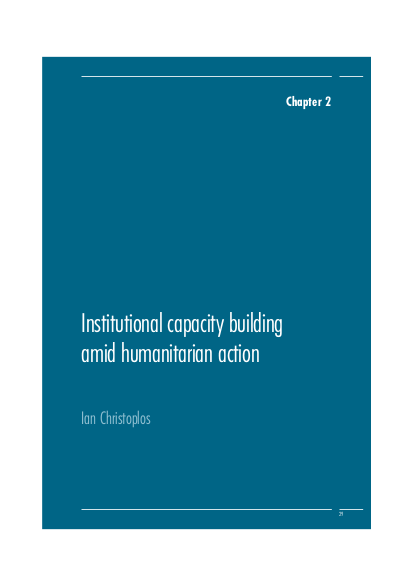
Institutional capacity building amid humanitarian action.
It is difficult to find anyone in the humanitarian sector who is openly against building local institutional and human-resource capacities. Humanitarian proclamations, plans, programmes and procedural guidelines abound with statements about the array of benefits that the sector will gain when local organisations and nationally recruited personnel take their rightful place in the system. These declarations stress the importance of making investments to ensure that this happens. It is equally evident that capacities are not being built or utilised at the pace that these claims would imply to be essential. Past ALNAP Reviews of Humanitarian Action note that evaluations show that agencies are failing to live up to their commitments to build the capacities of their local partners. The 2002 and 2003 Reviews drew attention to a long list of examples of over-reliance on international staff for tasks that could be managed more efficiently and effectively by local staff and organisations. Headquarters’ declarations of the importance of developing and utilising local capacities were being quietly forgotten in field-level operations. With some notable exceptions, there are few indications that the ‘business as usual’ of humanitarian operations led by international staff, is actually in question. Local institutional capacity building is not a central feature of humanitarian action today because, although local capacities are useful, they are generally not thought to be essential. The poor performance in building local capacity is widely acknowledged and it is not the purpose of this brief overview to accumulate further documentation of this failure. Neither is this review intended as a call to grand reform the humanitarian system so as to put local organisations in the driver’s seat. Other more extensive surveys in recent years have presented powerful arguments for such an overhaul (Kathina Juma and Suhrke, 2002; Smillie, 2001; Africa Humanitarian Action, 2004). Perhaps the main message of these studies is that a long-term perspective is needed, with longer-term funding, partnerships and engagement in processes bridging the divide between humanitarian and development programming. All these are essential components of a genuine commitment to ensuring that local institutions take on leading roles in humanitarian assistance. There is no indication that such a fundamental change is coming.
These reviews have presented Southern/Eastern perspectives (Kathina Juma and Suhrke, 2002; Smillie, 2001). For better or for worse, ALNAP is dominated by Northern organisations and therefore any attempt to speak on behalf of the South and East would ring hollow. ALNAP’s added value is rather in being able to contrast Northern perspectives with this Southern/Eastern critique within an analysis of the internal dynamics of the humanitarian system. These different perspectives need to be brought together if a more constructive process is to emerge.
Resource collections
- UN Habitat - Urban Response Collection
- Urban Response - Urban Crisis Preparedness and Risk Reduction
- Urban Response Collection - Community Engagement and Social Cohesion
- Urban Response Collection - Economic Recovery
- Urban Response Collection - Environment and Climate Change
- Urban Response Collection - Housing, Land and Property
- Urban Response Collection - Urban Crisis Response, Recovery and Reconstruction
- Urban Response Collection - Urban Resilience
